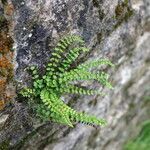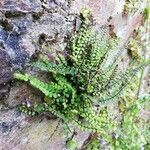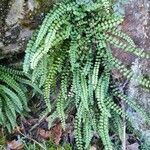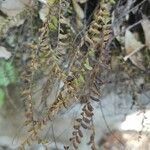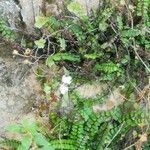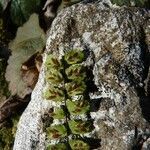Roots not proliferous. Stems short-creeping, often branched; scales black throughout or with brown borders, lanceolate, 2--5 × 0.2--0.5 mm, margins entire to denticulate. Leaves monomorphic. Petiole reddish brown or blackish brown throughout, lustrous, 1--4(--7) cm, 1/6--1/4 length of blade; indument absent or of black, linear-lanceolate or filiform scales at base. Blade linear, 1-pinnate, 3--22 × 0.5--1.5 cm, thin, glabrous or sparsely pubescent; base gradually tapered; apex narrowly acute, not rooting. Rachis reddish brown throughout, lustrous, glabrous or nearly so. Pinnae in 15--35 pairs, oblong to oval; medial pinnae 2.5--8 × 2.5--4 mm; base broadly cuneate, with or without low, rounded acroscopic auricle; margins shallowly crenate to serrate or ± entire; apex obtuse. Veins free, evident. Sori 2--4 pairs per pinna, on both basiscopic and acroscopic sides. Spores 64 per sporangium. 2 n = 72, 144.
Rhizome stout, ascending, invested with bases of fallen stipites, clad in dark linear-acuminate paleae up to 5 mm. long; stipites numerous, tufted. Stipes stiff, wiry, erect or ascending, dark brown, shining, 1-10 cm. long, paleate at base, elsewhere nude or nearly so. Rhachis stiff, dark brown, very narrowly winged, with rather distant subopp. pinnae. Lamina linear, 5-30 cm. long, subcoriac., dark green. Pinnae subsessile by narrowed base, 30-40-(80); oblong to obovate-oblong, occ. auricled, crenate-serrate to subentire, obliquely cuneate at base; larger 5-12 × 3-5 mm.; veinlets obscure, pinnate, forked. Sori cop., oblique, often confluent and covering whole of under-surface, up to 3 mm. long; indusium firm.
Rhizome erect, c. 2 mm in diameter, set with lanceolate, attenuate, minutely serrulate, dark brown rhizome-scales up to 4 mm long, often with paler reddish brown margins. Fronds tufted, firmly membranous, gemmiferous; stipe castaneous, usually less than v6 lamina length, glabrous; lamina narrowly linear, up to 150 x 15 mm, somewhat tapering basally, pinnate; pinnae in up to 32 pairs, broadly oblong-circular, the unequally cuneate base forming an angle of 90o, outer margin crenate to dentate, upper surface glabrous, lower surface set with scattered, minute, pale or dark, 1-or 2-celled scales. Sori 2 to 7 per pinna, c. 1.5 mm long; indusium yellowish membranous, erose, c. 0.3 mm broad.
Fern with erect fronds. Rhizome erect, scaly. Stipe and rachis dark red-brown, shiny, stiff, ± glabrous; stipe 1–4 cm long, c. 0.5 mm diam. Lamina linear, pinnate, 4–20 cm long, 5–19 mm wide, dark green, ± glabrous. Pinnae in 8–30 pairs, oblong to oval or ± rounded; bases cuneate, shortly stalked; margins dentate, serrate or ± entire; apices obtuse; longest pinnae 3–10 mm long, 2–7 mm wide, decreasing gradually upwards and ending in an enlarged terminal pinna; lower pinnae often deciduous, leaving short projections. Sori to 4 mm long. Perispore dark, with smooth or fimbriate narrow ridges and tuberculate or ribbed lacunae.
Rhizome 1.5–2 mm thick, the lanceolate brown scales 1.5–2 mm; lvs numerous, 5–25 cm, the purple-brown petiole to 6 cm; blades uniform, linear, pinnate throughout, to 19 × 1.7 cm, acute to attenuate above, usually not narrowed below, thin, dark green, the thin, flexible rachis almost wholly dark; pinnae 9–20 pairs, mostly opposite, oval to round oblong, oblique with the upper side the larger, but not auriculate, 4–8 × 3–6 mm, mostly crenate, subsessile; 2n=72, 144. On shaded, mostly calcareous rocks; interruptedly circumboreal, and nearly throughout our range, s. to Ga. and Tex.
Rhizome erect, up to 3 mm in diam., with dark brown to black lanceolate scales with pale margins, up to 4 x 1.5 mm. Fronds many, caespitose, erect to spreading, up to 110 mm long. Stipe black, wiry, brittle, up to 20 mm long. Lamina 1-pinnate, linear, up to 100 mm long, with up to 32 pinna pairs. Pinnae sessile, broadly oblong-circular, shallowly crenate, up to 6 x 3.5 mm, herbaceous, glabrous adaxially, sparsely scaled abaxially, more widely spaced and reduced towards base. Sori 2-7 per pinna. Indusium oblong, erose.
Rhizome erect, set with dark brown rhizome-scales. Pinnae shortly petiolate, broadly oblong-circular, unequally cuneate base forming an angle of 90°, outer margin crenate to dentate. Lamina narrowly linear, up to 150 x 15 mm.
Perennial with erect rhizome. Fronds tufted, to 18 cm, stipe glabrous, lamina linear, pinnate, pinnae to 8 mm long, to 32 pairs, broadly oblong-circular, minutely scaled beneath. Null Sori 2-7 per pinna, indusium erose.
A small fern. It grows 5-15 cm high.
